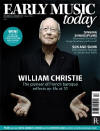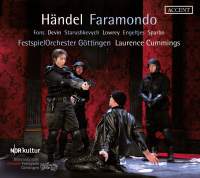Texte paru dans: / Appeared in:

Early Music Today (12/2014- 02/2015)
Accent
ACC26402

Code-barres / Barcode : 4015023264021
Consultez toutes les évaluations recensées pour ce cd
~~~~ Reach all the evaluations located for this CD
Outil de traduction (Très approximatif)
Translator tool (Very approximate)
Handel's biographer Paul Henry Lang thought the 1738 Faramondo libretto 'so whittled down and twisted around' (compared to Zeno's 1699 original) that 'it resists any reasonable analys'. Unfortunately, Accent's booklet compounds the confusion:it reprints the English translation from Handel's premiere, with its convoluted syntax ('And then? But ah! I ought to think, / I, the author of my fair, engage'), and its English synopsis mistakenly reproduces the plot outline of Siroe, from Laurence Cummings' previous Handel recording for the label. On the plus side, Lang praised Handel's music for its 'light and elegant' textures and 'sprightly' rhythms, and these qualities are brilliantly captured by Cummings' orchestra on this live recording from the 2014 Gottingen festival.
Despite the music's charms, few arias carry any real emotional clout and several seem ill‑suited to the dramatic context. Handel gives Faramondo the most attractive tunes ‑ the role marked the London debut of his new star castrato Caffarelli ‑ but only 'Voglio che sia l’indegno', with its swirl of contrary feelings, can compare with his finest arias. Mezzo‑soprano Emily Fons delivers it with thrilling bravura here, and Cummings' principals sing well, although it's the stellar trio of countertenors (Max Emanuel Cencic, Philippe Jaroussky and Xavier Sabata) on Diego Fasolis' rival Virgin Classics set who probably come closer to redeeming what Winton Dean tactfully designated 'a very uneven opera'.
Cliquez l'un ou l'autre
bouton pour découvrir bien d'autres critiques de CD
Click either button for many other reviews


